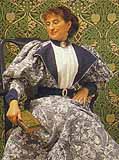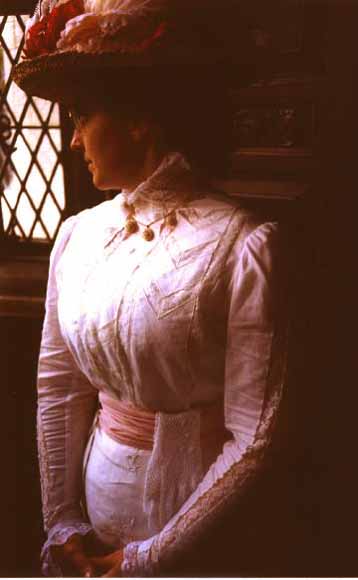
ILLUSTRATIONS OF LADIES’ EVENING DRESS
OF THE 1850s AND 1860s
LARGER IMAGES OF FASHION PLATES AND ORIGINAL DESCRIPTIONS.
Fashion Plates from Godey’s Lady’s Book, Peterson’s Ladies’ National Magazine, The Englishwoman’s Domestic Magazine; and Demorest’s Illustrated Monthly and Demorest’s Mirror of Fashions
|
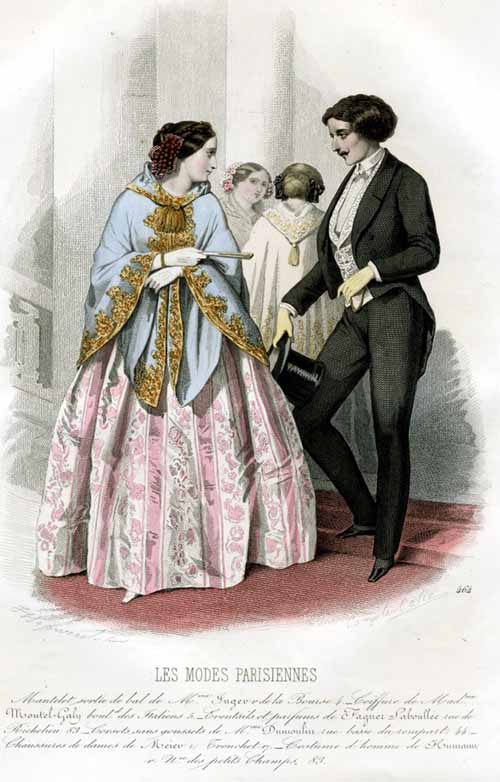
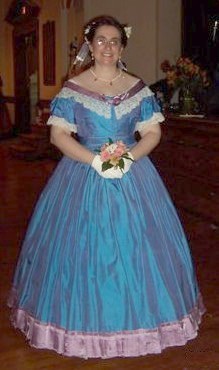
|
Table of Contents:
- Dress for receiving New Year’s calls, 1854
- Bridal, bridesmaid, and guest’s gowns, 1856
- Group of evening dresses, 1857
- Bridal, bridesmaid, and guest’s gowns, 1856
- Evening Dress, 1859
- Tunic dress; robe with double skirt; tunic dress; tarleton dress, 1859
- Evening dresses; dress for the opera, 1860
- Evening dress of white tulle; evening dress of white crepe, 1860
- The “Juliet” flounced robe, 1860
- Dinner dress of embroiderded muslin; evening dress of white silk, 1860
- Evening Dress for the Sea-Side, 1860)
- Evening dresses, 1861
- Ball dress; evening dress, 1862
- Evening dress of barege; evening dress of grenadine, 1862
- White high bodices for evening wear, 1863
- Evening dress of organdie, 1863
- Evening dress; gored dress; robe of organdy; robes of organdy and Swiss; girl’s dress of lawn, 1865
Related Pages:
|
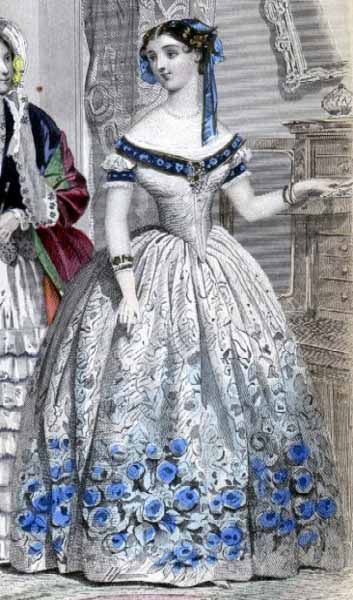 |
| Godey’s Lady’s Book, January 1854 |
|
Description of steel fashion-plate
for January, 1854 (Godey’s Lady’s Book).
Fig.2d. - Dress for receiving New Year’s calls. A white grounded silk,
the skirt elegantly
woven with a pattern of full-blown roses and foliage in blue. Plain white body and sleeves, finished
with broad bands of blue embossed velvet. Pearl ornaments. The Hair slightly puffed, and
dressed with lappets of blue and gold ribbon, intermingled with golden leaves.
|
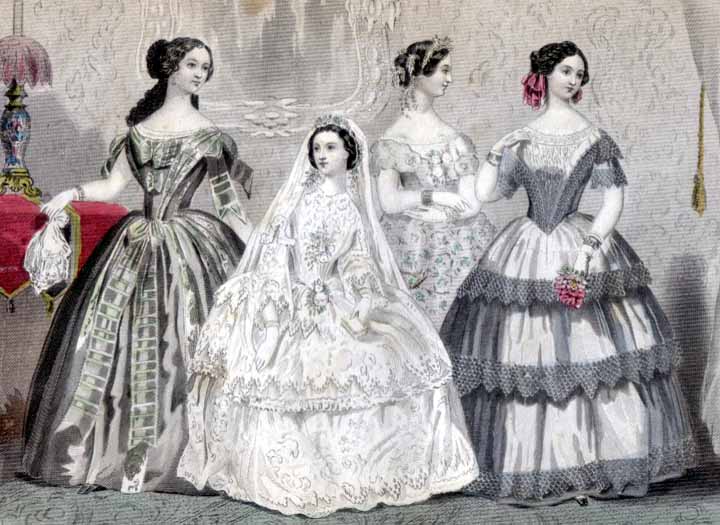 |
| Godey’s Lady’s Book, January 1856 |
|
| |
|
Description of steel fashion-plate for January, 1856 (Godey’s Lady’s Book).
INTERIOR OF A DRAWING-ROOM. BRIDAL RECEPTION.
Fig. 1st. -The bride is, of course, the principal figure in the group, around which all the
rest centre. Dress of white silk, with three lace flounces, the upper one falling directly from the
waist; lace to correspond is also gathered in a slight fullness over the corsage, and falls over the
open sleeve. Bouquets, wreath, and cordon of white roses, orange-flowers, and jessamine, with light
foliage; veil of thulle, wide and full.
Fig. 2d. - Bridesmaid in a dress of white silk, brocaded with rosebuds, and foliage natural
shade. Bouquet de corsage, white roses and jessamine wreath; jessamine and acacia buds drooping in
cordons.
Fig. 3d. - Guest at the ceremony. Silk robe, with flounces, sleeves and bretelles; a rich
pattern woven à disposition. Hair in bandeaux, crossed by a Grecian braid over the brow.
Fig. 4th. - Guest at reception. Rich taffeta in alternate plain and brocaded stripes;
trimming of bretelles, bows on the shoulder, and sash to correspond. Hair in waved bandeaux,
finished at the back with a barbe of black lace.
Top
|
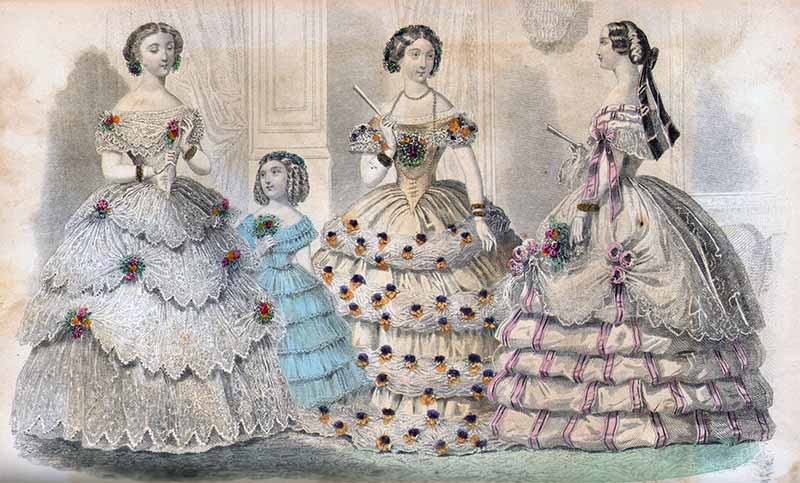 |
| Godey’s Lady’s Book, October 1857 |
|
| |
|
Description of steel fashion-plate for October 1857 (Godey’s Lady’s Book).
GROUP OF EVENING DRESSES.
Fig. 1.—Bridal-dress, transformed into a party-dress, by laying aside the veil, and looping the lace with bouquets
of bright field flowers. The material is of course white silk; the rich flounces, four in number, graduated as to depth; berthé
and sleeves to correspond. Hair arranged simply, with bouquets of field flowers placed quite low on either side of the Grecian plait, in which the puffs terminate
Fig. 2.—Dress of fawn-colored silk, with a double skirt, though the trimming is so arranged as to give the affect
of four. The upper jupe is quite short, and bordered by a very full waved puffing of transparent thulle, caught up by a single heart’s-ease*
of purple and gold, at very short intervals; berthé and sleeves of the same; bouquet de corsage, and wreaths for the hair of
heart’s-ease, in which purple predominates, and foliage of the same.
Fig. 3.—Dress of white silk, with five full puffs crossed or looped by rose-colored ribbon; a deep flounce or
jupe of lace, caught up by full blown roses, without foliage, falls from the waist. The berthé, which shades the arm in lueu of a
sleeve, has three puffs, with a simple cache peigne* of broad velvet ribbon.
Fig. 4.—Child’s dress of blue tarleton, with flounces; wreath of forget-me-nots for the hair.
Notes: Fig. 2. Heart’s-ease is a tri-colored wildflower, viola tricolor, like a small pansy.
Fig. 3. cache peigne is translated as comb hider, is a style of headdress or hat decoration.
Fig. 4. Tarletan is a thin, stiffened, open-mesh cotton fabric.
Top
|
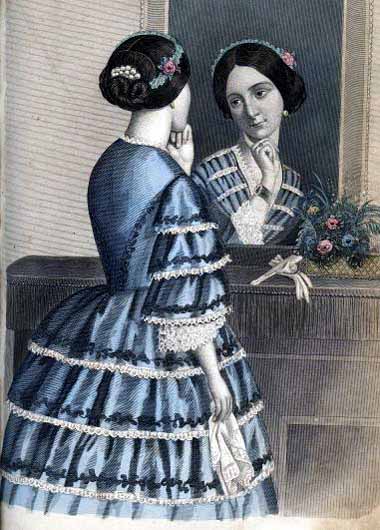 |
| Godey’s Lady’s Book, February 1856 |
|
Description of steel fashion plate
for February
By Happy Conception of the artist, we have at once the front and reverse of the single graceful
figure in evening-dress.
The robe is of steel-colored silk, with a raised pattern of black velvet in
flounces, which are also edged with a heavy point lace. The sleeves, in three flounces, correspond
precisely to the skirt. The back of the corsage is plain; the front draped, and fastened by bands of
the point. Hair in full bandeaux, fastened by a pearl comb, a cordon of the point passed
across the brow, fastened by a single black rose and foliage. For a dinner dress, nothing could be
more simple and elegant.
Top
|
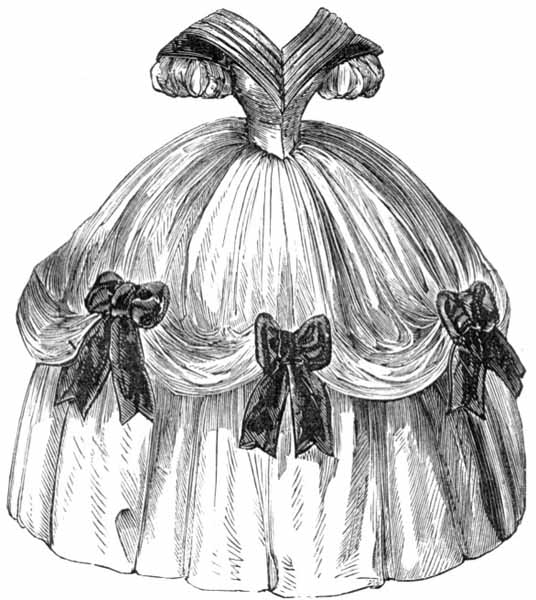 |
| Godey’s Lady’s Book, October 1859 |
|
Evening Dress
In selecting one of the newest and prettiest dresses of the season for
illustration, we have been influenced by its simplicity of style and taste. To be
appreciated, it must be seen in contrast with those which are loaded with ornament. This
dress is made in pink tarleton. It has a double skirt; the upper one is looped up with
large bows of black velvet ribbon. The body is made round at the bottom, and finished with
a draping of folds at the top. The sleeve is peculiar; it consists of a broad fold of the
tarleton, plaited into the armhole, surmounted by an epaulette in black velvet, not
compressed down to the arm, but adapting itself to the spread of the folds of the tarleton.
Under all is a short, full sleeve, of sheer, white tarleton, which produces the best effect
by the relief which it affords. The same dress is also made in white tarleton, having rows
of white satin ribbon and white satin epaulette. This very pretty fabric has a peculiar
advantage for evening wear, as it lights up remarkably well.
Top
|
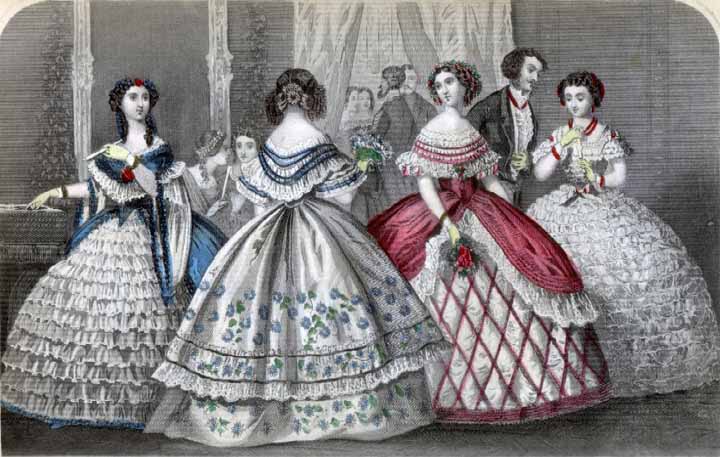 |
| Godey’s Lady’s Book, December 1859 |
|
| |
|
Description of steel fashion plate for December, (Godey’s Lady’s Book, December 1859)
The commencement of the season for evening gatherings naturally directs us to the dress
suited for them.
In Fig. 1. we have one of those characteristic tunic dresses, introduced of late, and
notable for their novelty at least. Underskirt or petticoat of white silk, covered by
innumerable small flounces. Tunic and corsage of blue satin; sleeves of white silk, with a
ruche of blue; berthé trimmed with point lace.
Fig. 2. Robe with double skirt, a broché pattern of purple Prussian flowers
and leaves on a white ground. The upper skirt has, besides the pattern, a puff of the same,
caught on each side by a narrow velvet ribbon, and edged with blonde. The berthé quite
new or in style, and the sleeves are composed of blonde and purple velvet ribbon. Bouquet of
passion flowers.
Fig. 3. Tunic dress; petticoat of white satin drawn into diamond-shaped puffs by
crossings of currant-colored taffeta, with a fall of blonde, blonde sleeves and berthé.
Wreath of currant and green leaves.
Fig. 4. Tarleton dress for a young lady, the whole formed of puffs; corsage cut
square; coral ornaments. Strands of coral in the hair.
Top
|
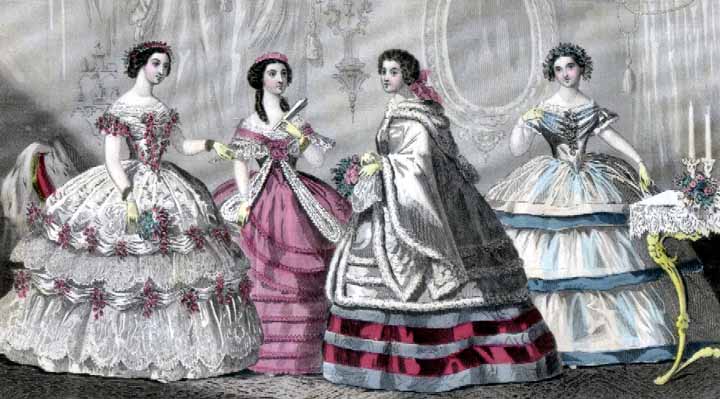 |
| Godey’s Lady’s Book, February 1860 |
|
| |
|
Description of steel fashion-plate for February, 1860 (Godey’s Lady’s Book).
Fig. 1. -Evening-dress of white silk, with two skirts; the lower one has a flounce of
lace, headed by a puffing of silk, caught at intervals with sprays of crimson salvia; the upper
skirt is in longitudinal puffs, finished in the same manner; puffed and pointed corsage trimmed
with salvia; round wreath of the same for the hair.
Fig. 2 -Evening-dress of sore-colored silk; the lower skirt trimmed with four
straight flounces, or single folds of the silk, edged by a shell rouche of the same; the upper
skirt has corresponding volantes arranged as a tunic to the right; low pointed corsage, with
Grecian folds, trimmed by a flounce and heading of lace, the fall is crossed at the bouquet
de corsage, and is continued in graceful lapels. Round wreath of blush roses without
foliage, as in bouquet de corsage.
Fig. 3 -Dress for the opera. Material, gray moire, with ribbons of deep bright
crimson sewn on flat. Opera cloak of white cashmere, trimmed by several rows of swan’s-down;
Olga sleeve, and graceful hood with tassel.
Fig. 4 -Evening-dress of white silk, with triple flounces, very deep; under each
flounce of white appears an alternating flounce of blue; the drapery of the corsage and the
sleeves has the same feature. Wreath of blue convolvulus, with foliage and tendrils.
Top
|
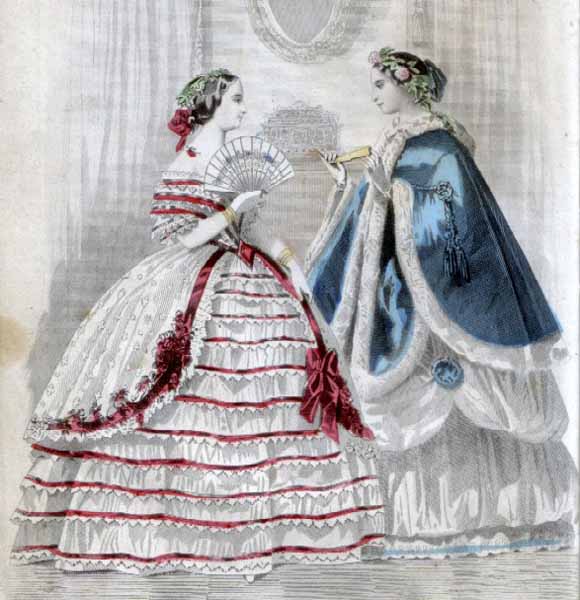 |
| Peterson’s Magazine, January 1860 |
|
Fashions for January 1860
(Peterson’s Magazine).
Fig. I. -Evening-dress of White Tulle, trimmed with eleven narrow tulle flounces, edged with
blonde and narrow currant-colored velvet. A tunic of spotted tulle is trimmed with a broader
velvet, a long wreath of velvet flowers, and a large bow of velvet ribbon. The sleeves and the
berthe, which is of a heart shape, are trimmed to correspond with the skirt. Wreath of green
leaves and velvet flowers.
Fig. II. -Evening-dress of White Crape. -The edge of the lower skirt is ornamented with a
blue ribbon quilling. The upper skirt is festooned on one side with a large blue rosette.
Blue satin opera cloak, trimmed with heavy cords and tassels, and bands of swan’s-down.
Cleopatra wreath.
Top
|
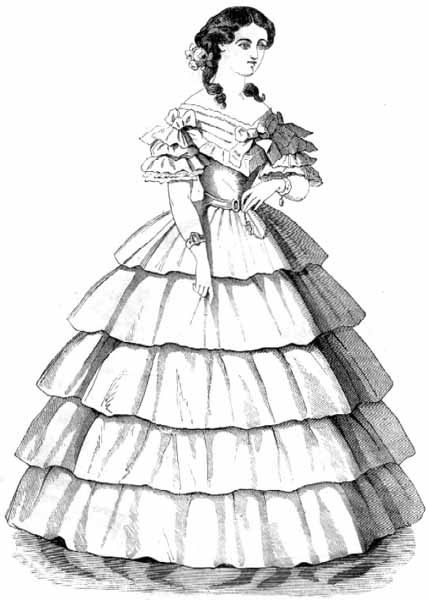 |
| Godey’s Lady’s Book, May 1860 |
|
The Juliet (Godey’s Lady’s Book, May 1860)
Five flounced robe, also suitable for the street and evening-dress. This robe is from the
establishment of Messers. T. W. Evans Co., 818 and 820 Chestnut Street, Philadelphia.
Top
|
Fashions for July.
Fig. 1 - DINNER DRESS OF WHITE EMBROIDERED MUSLIN, WITH THREE FLOUNCES; below each flounce is a
plating of green ribbon. The sleeves and cape are trimmed to correspond with the skirt of the dress. Sash of green and white
ribbon. Head-dress of green and white ribbon loops.
Fig. 2 - EVENING DRESS OF WHITE SILK. - The bottom of the skirt is finished with a puffing of white tulle. A white tulle dress is
worn over the silk, and has two black lace flounces, each headed with a quilling of pink ribbon. The lower flounce is put on in
festoons, in each of which is a medallion, composed of pink ribbon quillings and black lace, pink ribbon, and tulle. head-dress
of black velvet loops and ends, pink roses and black lace.
Peterson’s Magazine
July 1860
|
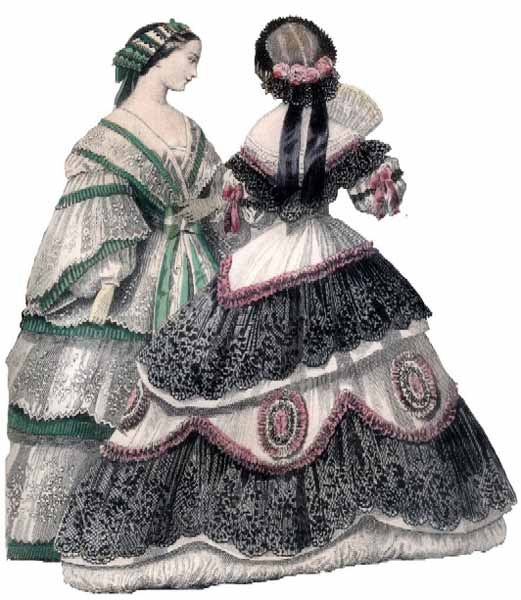
Top
|
EVENING DRESS FOR THE SEA-SIDE.
|
|
Dress of clear muslin, worn over a slip of clear silk, having the corsage low, and en cœur in
front, demi-low at the back, and short sleeves. The corsage of the dress has the right side crossed over the left, and it has
revers in the shawl form, lined with green silk and trimmed with narrow lace. The corsage is rather short-wasted, not pointed.
Ceinture of green ribbon, with flowing ends, fastened in a bow on one side. The sleeves consist of four puffs of muslin,
separated by rows of green ribbon. The lowest puff is finished by a band of green ribbon, beneath whish is a frill of white
lace. In the inner part of the arm, a row of green ribbon passes up the whole length of the sleeve. The skirt is full and
gathered in at the waist. A full and deep flounce, surmounted and edged by a bouillonné and a narrow flounce, trims the lower
pert of the skirt at the back and sides. The two ends of this flounce, gradually diminishing in depth and fullness, pass up
each side of the front as far as the waist. between them is a space, forming a tablier front, trimmed at the lower part with
six narrow flounces, edged with green ribbon, and disposed in the form of a festoon.
Godey’s Magazine
September 1860
|

Top
|
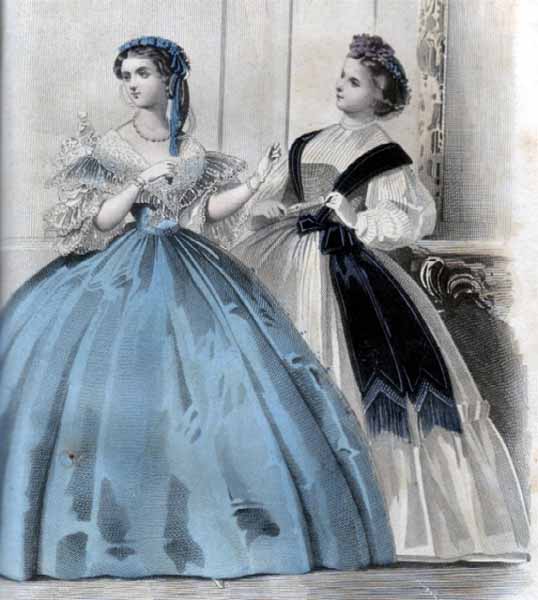 |
| Peterson’s Magazine, July 1861 |
|
Fashions for July 1861
(Peterson’s Magazine).
Fig. 1 - Evening Dress of light Blue silk. - The skirt is made quite plain, and the body low
with short sleeves. A cape of figure lace and short puffed sleeves to correspond, complete this
charming costume. The head-dress is composed of a wreath of blue, and blue velvet and silver cord.
Fig. 2 - Evening Dress of white muslin. - The skirt has one deep flounce, with
a narrow ruffle as a heading. The body and sleeves are composed of fine tucks or plaits, and are
finished with a narrow Valenciennes edging. The braces, sash, and pointed belt are of black
velvet, trimmed with a gold braid. head-dress of black lace and flowers completes the costume.
Top
|
|
Description of the colored plate,
(Englishwoman’s Domestic Magazine, February 1862)
BALL DRESS. - The wreath is composed of geraniums, is made full and high in the front, and
open behind, terminating on each side with a spray of flowers. The hair is plated behind, and
dressed in loops. The dress is exceedingly elegant when made up, and may be composed of
tarletane, crêpe, or silk, or a mixture of crêpe and silk. As the latter is by far
the prettiest mode of making this dress, we will give the description of it in those materials.
The underskirt is composed of white glacé silk, ornamented at the bottom with four
puffings of cerise or pink silk, each puffing being edged with narrow black blonde. The upper
skirt, which is of white crêpe, is as long as the silk skirt, and is looped up on
each side, just above the top puffing, with large bunches of geraniums and wreaths of the same
flowers, which are carried to the point of the body. The body is made of plain white silk, and
the berthé of white crêpe, cut pointed, and ornamented with two rows of quilled silk
ribbon, edged with black blonde. The sleeve consists of one large puff of white crêpe,
finished off with a small bunch of geraniums, whilst a bouquet of the same flowers ornaments
the dress on front. The dress would look very pretty made entirely of crêpe, with pink
crêpe puffings, or it might be composed of tarlatane, the latter material being the most
inexpensive to use for a ball dress. Blue trimmings might be used with good effect for a
blonde complexion.
Top
|
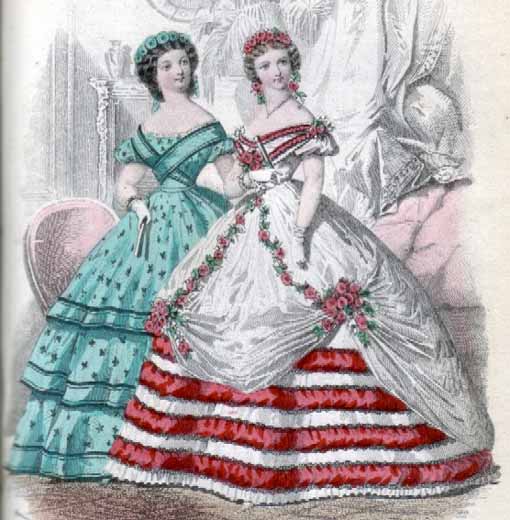 |
| Englishwoman’s Domestic Magazine, February 1862 |
|
EVENING DRESS. - The wreath is composed of graduated roses, finished off behind with two
hanging sprays. The dress is of green tarlatane, figured with black leaves, and trimmed with
black velvet. It is made with three skirts, trimmed with plain sarsnet ribbon, edged with broad
and narrow black velvet, there being four rows on each skirt. The body has a round waist, is
quite plain, with simple puffed sleeves, and a green silk band. The braces, which cross behind
and before, are of green ribbon, trimmed with black velvet, the braces being shaped to a point
at the waist.
Top
|
Fashions for July.
Fig. 1 - Evening Dress of White Barege, trimmed with two rows of black guipure lace. Bournouse of
white barege trimmed like the dress.
Fig. 2 - Evening Dress of Pink Grenadine.-The skirt is trimmed with puffings of grenadine, lengthwise of the skirt,
edged with narrow white blonde. Sleeve reaching to a little below the elbow, made quite wide. The body is pointed both back and
front, and has a square trimming of puffed grenadine.
Peterson’s Magazine
July 1862
|
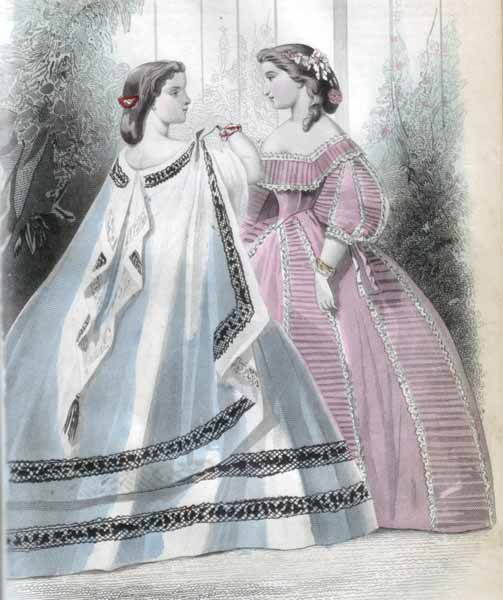
|
WHITE HIGH BODICES FOR EVENING WEAR are now displayed in great variety, and many of them are very
tastefully arranged. The most novel are those which simulate a high and low bodice in one; the top being composed of plain
organdy muslin, and the lower part of straps of embroidered muslin insertion, and Valenciennes lace laid on so as to give the
appearance of a low bodice; These are generally finished off round the shoulders and throat with Valenciennes lace, and at the
waist with a Swiss band in black velvet or taffetas. Lace tuckers are still composed principally of Valenciennes lace and tulle
illusion. As low bodices are now cut so low as to require very wide tuckers, puffings of tulle and clusters of small loops of the
narrowest ribbon velvet, placed at equal distances, are necessary, as well as the Valenciennes edging. The black velvet, which is
introduced into the edging to hold the tucker in, should be tied in the front as well as the back; by doing so, the tucker will
set more evenly and securely.
Peterson’s Magazine
July 1863
Top
|
|
Fashions for July.
Fig. IV.—Evening Dress of White Organdie, figured with green leaves. The skirt has two ruffles
around the bottom, the upper one passing up the right side of the dress in the tunic shape. Short puffed sleeves, and berthe of
the same material as the dress. Green grasses and roses in the hair.
Peterson’s Magazine
July 1863
|
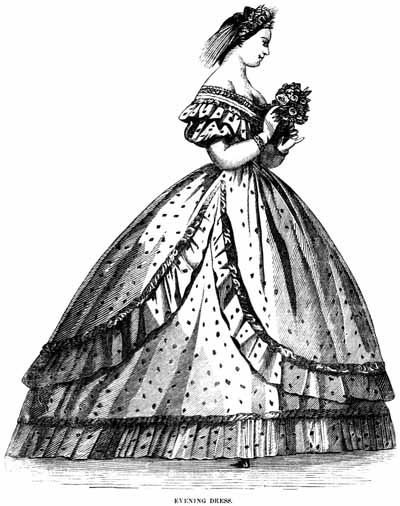
Top
|
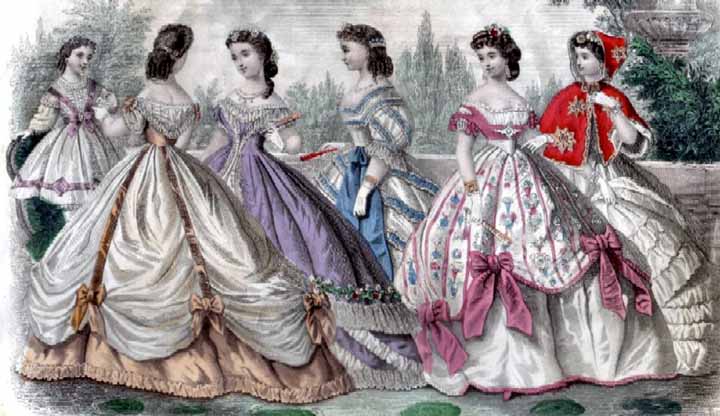 |
| Mme Demorest’s Mirror of Fashions, July 1865 |
|
|
Description of colored steel plate.
Fig. 1.—Maize or corn color is destined to be a great favorite for dinner and evening dress at the
watering-places. It lights up very brilliantly, but is infinitely more beautiful when toned down by gauze or illusion. This
illustration presents a dress of maize-colored taffetas, finished with a quilling of the same upon the bottom. The over-skirt is
of white tulle, festooned with bands of maize extending from the waist and ending in bows with ends; sleeves and berthe of tulle,
puffed, with maize shoulder knots.
Fig. 3.—Gored dress of rich purple silk. A fall of white lace, headed by a vine of artificial leaves and berries, is set
on the skirt to resemble a tunic; from beneath this, puffings of tulle running diagonally to meet a second flounce of lace from
the under-skirt; a puffing of illusion around the shoulders and bretelles of lace.
Fig. 3.—Robe of white organdy. The body is square at the neck, has a round waist,, and large puffed sleeves reaching to the
elbow, where they are gathered into a band, below which is a frill of lace. The trimming, blue ribbon edged by narrow flutings of
lace, begins at the sash of the waist, and forms one continuous chain upon the skirt, as shown in the design. A braided coronet
upon the head, ornamented by three gold stars, one in the center and one at each side. The hair is brown back plain over the
ears, and falls in short curls upon the neck. Grecian combs and bracelets.
Fig. 4.—Dress of white silk, with figured silk tunic, caught up in large scollops by pink double bows and ends. The waist
is pointed, the neck square, with square pink berthe. Both the dress and tunic are finished at the bottom with heavy cable cord.
Fig. 5.—Robe of very fine French Swiss, made with three deep puffings upon the skirt, worn over an under-skirt of the same
material, also puffed. The waist and sleeves, hidden by the ”Alpha” or Saratoga cloak, are trimmed to match. The “Alpha” itself
is quite a pretty feature of this toilet. It is a short talma of scarlet merino, lined with white silk. The hood is large and
loose, like that of a domino, lined with silk and ornamented with bullion stars. The cape is also trimmed with the latter, and
narrow gold lace laid plain upon the material. It is altogether decidedly jaunty and coquettish, a vivid dash of color to gleam
amid the sea of fleecy tulles and spotless organdies.
Fig. 6.—Represents a little girl in a miniature gown of delicate snowy lawn. The skirt is plain, with a band of magenta
intersected with diamonds just above the hem. The waist has a little tucked bosom inserted. The sleeves are gathered in a band
at the wrist. A broad strap of magenta extends from the shoulder to the waist, crossing beneath the belt, of the same
hue.
Demorest’s Illustrated Monthly and Demorest’s Mirror of Fashions, July 1865.
Return to Top
Return to Library Index
|

P.O. Box 9, Nahant, Massachusetts 01908
e-mail:
phone: (781) 49-WALTZ (781-499-2589)
© 2014, Vintage Victorian, All rights reserved
|
|
|
Go to:

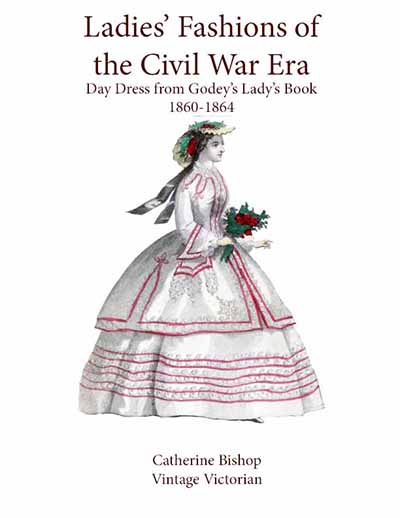



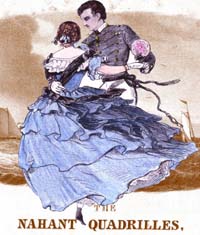
last updated 21 dec 2014/csb
|
